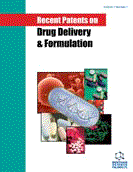Abstract
Background: Nasal inserts are novel, solid, bioadhesive dosage forms administered via nasal route for prolonged systemic drug delivery. The principle of the dosage form is that, after administration nasal inserts imbibe nasal fluid from the mucosa and form a gel in the nasal cavity in order to avoid foreign body sensation. The objective of this investigation was the development of chitosan/xanthan gum based bioadhesive nasal inserts of antimigraine drug.
Methods: Lyophilization is more usual technique for the preparation of nasal inserts and it is one of the applied methods for drying of solids either in the form of aqueous solution or rarely in the form of aqueous suspension by using freeze dryers. The recent patents on Biocompatible polymer (US20140301972A1), High molecular weight polymers (US20050048121A1), Migraine treatment (WO2009080764A3) helped in selecting the drug and polymers. A 32 factorial design was used to investigate the combined effect of two independent variables such as concentration of Xanthan gum (X1) and the concentration of Chitosan (X2), onto the water uptake, bioadhesion potential and drug release which were the dependent variables. Nine batches of the nasal inserts were developed and evaluated for water uptake at three different pH, bioadhesion potential and drug release. The optimized nasal inserts batch was also characterized by DSC, PXRD and SEM.
Results: The results showed that the water uptake ability of nasal insert was strongly influenced by pH of the medium and by polycation/polyanion concentration. This investigation verifies the formation of complexes between chitosan and xanthan gum and confirms the potential of these complexes, in achieving the sustained antimigraine drug delivery in the nasal cavity.
Conclusion: The best nasal inserts formulation containing chitosan and xanthan gum in the ratio 0.5:0.5, showed desirable % drug release as well as bioadhesion which may result in an increase in the nasal residence time.
Keywords: Lyophilized bioadhesive inserts, nasal delivery, natural polymer, polycation/polyanion, polyelectrolyte complexes, rizatriptan benzoate.
Graphical Abstract
 13
13 7
7














